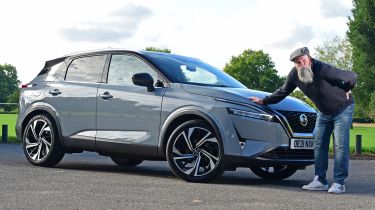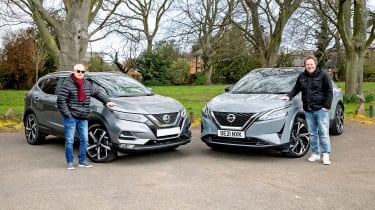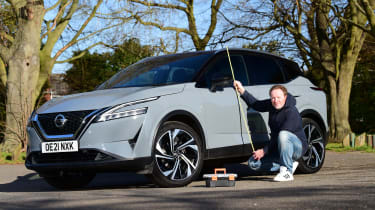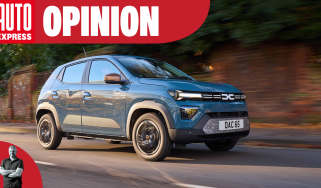Nissan Qashqai Tekna+: long-term test
Final report: the practical Nissan Qashqai is let down by comfort over long distances
Verdict
We’ve found it hard to fall in the love with the Nissan Qashqai. It’s great for the school run and short trips, because it’s very practical, but it’s not a comfortable SUV and we often found ourselves dreading longer journeys.
- Mileage: 14,346
- Economy: 35.1mpg
Maybe I’m just getting old. I am, in fact, now the wrong side of 40, but does that explain why I always feel so tired when I take our Nissan Qashqai on a long journey? I don’t ache when I get out of bed and I can still keep up with my son when he goes to rugby training, but I’m often hobbling about like a geriatric and complaining of a stiff back whenever I spend an extended amount of time in the driver’s seat.
One of the Nissan’s last jobs on our fleet was ferrying the family on a trip to the Forest of Dean for my wife’s birthday. It’s a drive of just under three hours, but really highlighted the car’s shortcomings. I find the ride too firm, and the seats a little too uncomfortable. I’ve tried various different seat positions to try to get it right, but nothing seems to work. Even the massaging seats on our top- spec Tekna+ don’t do the job, because they feel little better than being kicked in the back by one of the children.
I always think the sign of a good car is finishing a long trip as fresh as when you started it. I once drove an Audi A6 through the night to Wroclaw in Poland. On arrival, I genuinely hopped out without any problems, although I did admittedly stop a few times en route. It was just a lovely car to cruise in, but the Qashqai doesn’t have that feeling. Now, while the A6 obviously isn’t a rival, many of the other Auto Express fleet cars I’ve had, such as the SsangYong Korando and SEAT Tarraco, can be considered as such, and they never left me with an aching back.
Used - available now

2022 Nissan
Qashqai
32,521 milesAutomaticPetrol1.3L
Cash £17,776
2022 Nissan
Qashqai
65,578 milesAutomaticPetrol1.3L
Cash £18,600
2017 Nissan
Qashqai
54,865 milesManualDiesel1.5L
Cash £11,287
2018 Nissan
Qashqai
57,421 milesManualDiesel1.5L
Cash £9,600But the Forest of Dean trip emphasised what the Qashqai does well, too. It’s a very practical car. It may not be class leading in any one area, but it’s not weak in any either. It’s a good all-rounder and easily has enough space to transport a small family and their luggage. We loaded the boot with bags, coats, shoes and bedding, and there was plenty of extra space if we needed it.
Plus, if we wanted more room we could have taken the false floor out to increase the capacity. In fact, the split-level boot is a great selling point: it’s useful to have a flat loading area with no lip – especially when having to regularly lift a buggy in and out.
I’ve mentioned before how much I love the fact the rear doors open to 85 degrees, which means the kids can climb in and out without having to be lifted, and there’s plenty space in the rear of the cabin so it doesn’t feel claustrophobic.
But as good as the Qashqai is at coping with family life, most of the things I like can be had on a much lower-spec model. Our Tekna+ is packed with kit, but costs £38,815. That’s more than £12,000 extra over the £26,045 entry-level Visia, which would ride far better on its smaller 17-inch wheels.
That’s the problem Nissan has created itself. After spending the best part of a year with the car, I’ve realised that, by attempting to make it more premium, Nissan has moved the Qashqai away from what it does best. Buyers are not necessarily going to be interested in leather seats that kids will quickly ruin, or large alloy wheels that will be scratched at the first sight of a kerb.
Overall, I think it makes much more sense to save some money and stick to a lower-spec model; it’ll end up being a far better family workhorse.
Nissan Qashqai: third report
We get the verdict on the latest Nissan Qashqai from a Mk2 owner
- Mileage: 10,083
- Economy: 35.1mpg
When I first found out that I would be getting a new Nissan Qashqai to test for an extended period, there was one person I immediately thought would be interested: Ian Jebson.
Who? Well, Ian is my next-door neighbour, and he currently drives a second-generation Qashqai. In fact, he’s a serial Mk2 owner, having run one before trading it in for a Renault Kadjar, a car that shares its running gear with the Qashqai. Ian now has a 21-plate version of the Nissan, and I was interested to see what he thought about our new model. Ian’s Qashqai is an N-Motion DCT, a special edition that was ‘limited’ to 2,000 examples. Nissan offered him a great deal on it, too, with more than £10,000 off the list price. So instead of waiting for the imminent arrival of the new Qashqai, Ian made a huge saving.
Comparing his car with ours, Ian was initially surprised with how similar the two Qashqais are inside and out. Sure, there are some subtle differences, but it’s easy to tell that they stick to the same formula – and it’s one that sells in large numbers in the UK.
“From the outside it’s quite hard to tell the difference,” said Ian. “The headlights are slimmer, but the overall look isn’t a massive change. You can tell it’s a Qashqai.” Looking at the interior, he said, “The biggest difference is around the gearstick. That’s very different from how it looks in mine. The screen is slightly larger and the buttons now line up across the bottom, as opposed to down the side, but the overall look isn’t a surprise. Even the digital screen in place of the dials in mine has the same general look. I do like how you can connect your mobile phone wirelessly, though.”
As I’ve mentioned in my previous reports, I feel the Qashqai really excels when it comes to practicality. I recently loaded the boot up with some broken fence panels and it was able to take the lot with ease. In fact, the new model’s 479-litre boot is 49 litres larger than the previous car’s. However, the split-floor layout remains the same and this is something both Ian and I really like.
Being able to store items underneath the floor is useful, while the luggage boards also provide a flat surface to easily slide buggies and other heavy items out. “I store some old sheets underneath that I can use as covers for whenever I need to go to the tip,” Ian added. “The split level means I can just leave stuff there, freeing up the boot for anything else.”
Overall, Ian was impressed with the look of the new car, but does he wish he had waited and bought the latest model instead? “I’m happy with my decision,” he said. “It’s clear there are a few more modern touches, but not enough to make me regret my choice. The saving I made – I just couldn’t say no to that, so I’m happy.”
He’s got no complaints with the way his Qashqai drives, but I still find it to be the new model’s biggest weakness. The firm ride around town – which isn’t helped by the 20-inch wheels on our Tekna+ model – is jarring. I wouldn’t go as far as to call it unpleasant, but it’s not so enjoyable to drive.
Soon we’re going to swap our Qashqai for a Tekna model with a manual gearbox for a month, and I’m hoping the smaller 19-inch wheels will improve the ride quality, but we shall have to wait and see.
Nissan Qashqai: second report
Latest version of Nissan Qashqai measures up well as a family car
- Mileage: 9,410
- Economy: 35.2mpg
Our Nissan Qashqai has been leaving me confused. How can a car that doesn’t appear to be that big from the outside, feel so cavernous on the inside? It’s almost as if the external dimensions quoted by the brand aren’t accurate – to the point where I’ve had to get out a tape measure and check.
Look at a Qashqai parked on the road and I’m sure you’ll agree that it doesn’t look bigger than any other crossover, but that only tells half the story. The clever use of space on the inside means that I’m really starting to warm to the Nissan’s charms.
Every time the car is loaded up with my family, it never feels like we’re struggling for space. I have two young children – Hugo and Matilda – who use car seats, but there’s room to sit comfortably in the front without getting constantly kicked in the back. The generous amount of headroom also makes it feel like the whole cabin is light and airy, although that’s certainly helped by the very impressive full-length panoramic glass roof. It’s only available on Tekna models and above, but it’s definitely worth the money.
All this space is helped by lots of interior storage, with large door bins able to swallow water bottles, snacks and more, plus a split central storage area that easily takes a box of tissues, sanitiser and plenty of face masks.
It means all the clutter can be stored away without having to resort to the passenger footwell, like I’ve had to do in other cars.
Then there are the rear doors that open to 85 degrees – wider than any other car in this class. It may seem like a small detail, but it’s a huge help with two youngsters. Helping them in and out is so easy when the doors open that wide, because you can lean in without bumping your head and safely strap them in without having to stretch.
Features like this make living with a Qashqai so easy. From the powered tailgate to the automatic central locking, it’s packed with lots of genuinely useful things.
When you do the nursery run on a daily basis, you really start to appreciate how effective the Qashqai’s use of space and tech is. However, I’ll admit that I struggled to fall in love with the car when it arrived; it never gets me excited when I’m behind the wheel.
I find the engine can be laboured at times and the CVT gearbox takes a lot of getting used to, especially at lower speeds, when it feels like the car is going to stall. However, the biggest problem for me is the ride quality; just driving around town can feel a little tiresome as it crashes over bumps and ruts in the road. The large wheels don’t help, but they are only part of the problem; the suspension doesn’t seem suited to cruising around town. There’s no doubt the Qashqai trails behind some rivals in this respect.
As I mentioned in my previous report, I’ve also been disappointed by the fuel economy. I’m now almost 10,000 miles into my time with the car, but I’m only just getting over 35mpg. For high-mileage drivers, I’m sure it’ll be a deal-breaker and the sooner Nissan offers a wider choice of powertrains the better.
But, the way it drives and the fuel economy are not why the Qashqai has become such a big seller in this country. It’s all about how practical it is, and that’s something that I have really come to appreciate. The new version is also more spacious than ever and that’s what really matters when you’ve got a family.
Nissan Qashqai: first report
Lack of plug-in hybrid tech means disappointing economy from our Nissan Qashqai
- Mileage: 6,321
- Economy: 34.6mpg
You may have seen the new Nissan Qashqai advert on TV. It features the new crossover in all its glory, with forked lightning flashing everywhere and the tagline “electrified with mild-hybrid power”. Impressive as the advert looks, in reality mild-hybrid systems provide minimal electrical assistance – not even enough to drive a car on electric power alone. So why is Nissan using it as a major selling point?
With no diesel options available, Nissan has staked everything on mild-hybrid tech. The Japanese brand believes it boosts the efficiency of the Qashqai’s solitary engine – a 1.3-litre turbo petrol in two states of tune – enough to appease those who would have previously gone down the diesel route.
However, I’ve been disappointed with the economy since taking delivery of the Auto Express Qashqai in mid-October. I’ve used it for commuting and a few long motorway trips, but I’ve only averaged 34.6mpg.
The poor economy has made me wonder why Nissan didn’t add other powertrains to the range when the new Qashqai first went on sale. I can understand why diesel is no longer available, but almost every maker is bringing out plug-in hybrid versions of their new models these days.
As such, Nissan’s clever “e-Power” tech will be a welcome addition when it arrives next year. It uses a 1.5-litre petrol engine to charge a lithium-ion battery, which powers the wheels. However, if you want a brand-new crossover capable of 40mpg-plus now, there isn’t a Qashqai to cater for your needs.
But maybe it isn’t all Nissan’s fault. I never got a chance to drive the Qashqai before the UK switched to E10 petrol, but a couple of colleagues have complained that filling up with E10 has hit their fuel economy figures to the tune of 4-5mpg. Still, even if I went down the route of filling up with premium unleaded, I think I would struggle to get above 40mpg.
Despite my fuel economy woes, I have otherwise been delighted with the Qashqai. My model is a top-spec Tekna+ 158PS Xtronic Auto and it’s packed with useful kit as standard. This includes a Bose sound system, a head-up display, heated seats, a heated steering wheel, a rear-view camera with a full around-view monitor, a powered tailgate and 20-inch alloy wheels.
It’s not just the kit that really impresses, because the car feels extremely well built, with lots of high-quality materials used throughout the interior. The electric leather seats are very comfortable, while the huge panoramic sunroof lets plenty of light into the cabin. Everybody who has sat inside has been surprised by how luxurious it feels.
Practicality is also one of the Qashqai’s strong points. There’s plenty of room for two child seats in the rear and I don’t have to move my seat forwards to avoid any unwanted kicks in the back. Plus the rear doors open to 85 degrees, so it’s easy for my two children to get in and out.
The boot provides a capacity of 504 litres, which is more than enough for my needs. Indeed, it comfortably swallowed everything for a recent family trip to Wales, including a travel cot, buggy and a couple of bags. The boot floor can also be lowered to give a little extra storage.
On the road the Qashqai performs almost like you would expect it to. It won’t win any awards for the way it drives, but most people buying one aren’t going to be throwing it around corners on a winding B-road. It’s a comfortable cruiser and the engine always seems to have enough power.
I’m not a fan of CVT gearboxes, but the Nissan’s is amazingly smooth in town. So smooth you often don’t even notice it, but as soon you come to a motorway and need to put your foot down, the revs rise rapidly and the acceleration takes a while to arrive.
| Model: | Nissan Qashqai Tekna+ 158PS Xtronic |
| On fleet since: | October 2021 |
| Price new: | £37,175 |
| Engine: | 1.3-litre 4cyl petrol, 156bhp |
| CO2/tax: | 146g/km/£155 |
| Options: | Ceramic Grey Pearlescent paint (£745), two-tone ceramic grey and black pearl roof (£400) |
| Insurance*: | Group: 16 Quote: £497 |
| Mileage/mpg: | 14,346/35.1mpg |
| Any problems? | None |
*Insurance quote for a 42-year-old in Banbury, Oxon, with three points.



















